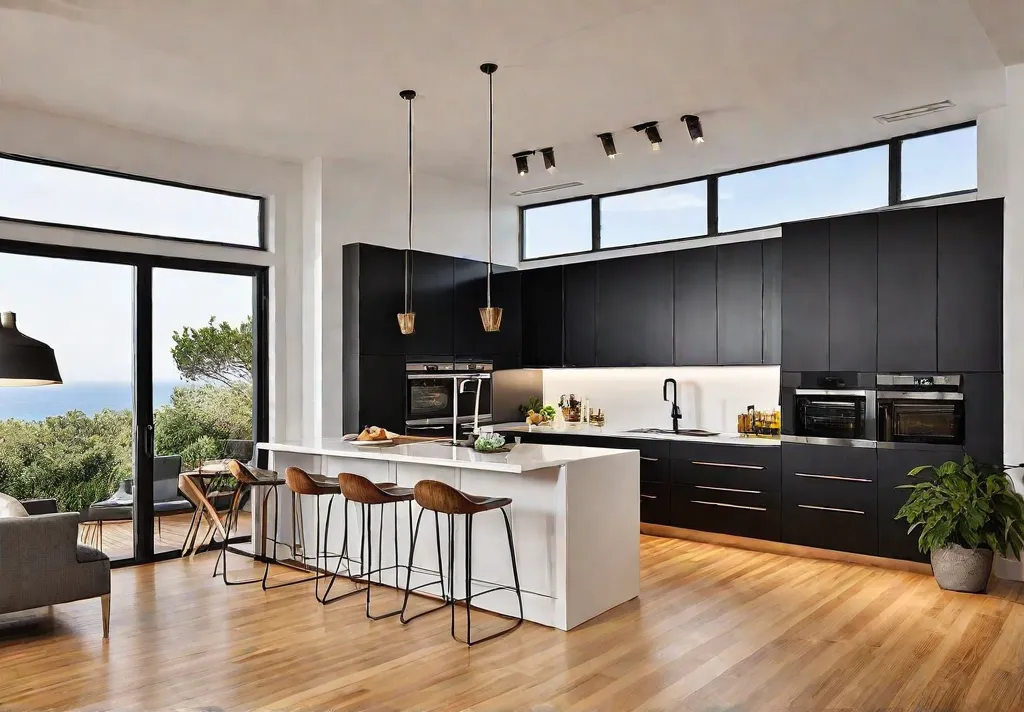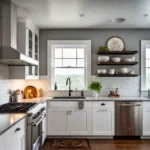Are you tired of the same old kitchen floors that don’t fit your vision of an environmentally-conscious home? Well, you’re in luck! These days, plenty of eco-friendly kitchen flooring options can transform your space while reducing your carbon footprint.
As a home decorator and design blogger, I’ve seen a significant increase in the demand for sustainable home renovations. More and more people are looking for ways to create beautiful, livable spaces that also align with their values and commitment to the planet. The kitchen—the heart of the home—is a great place to start.
In this article, we’ll explore eight fantastic eco-friendly flooring choices that can breathe new life into your kitchen while keeping the environment in mind. From rapidly renewable bamboo to recycled rubber and natural stone, there’s an option to suit every style and budget. Get ready to ditch the dated vinyl and upgrade to a floor that’s gorgeous and kind to the Earth.
Bamboo Flooring: A Sustainable Choice for Your Kitchen
Bamboo is a rapidly renewable resource that has become a popular eco-friendly alternative to traditional hardwood flooring. As a home decorator, I love using bamboo in kitchens because of its sustainability, durability, and versatility.
Bamboo is classified as a grass, not a tree, and it grows incredibly fast – some species can reach maturity in just 3-5 years! This rapid growth rate makes bamboo a highly sustainable choice compared to hardwoods, which can take decades to regrow. Plus, bamboo flooring is often more affordable than traditional hardwood options.
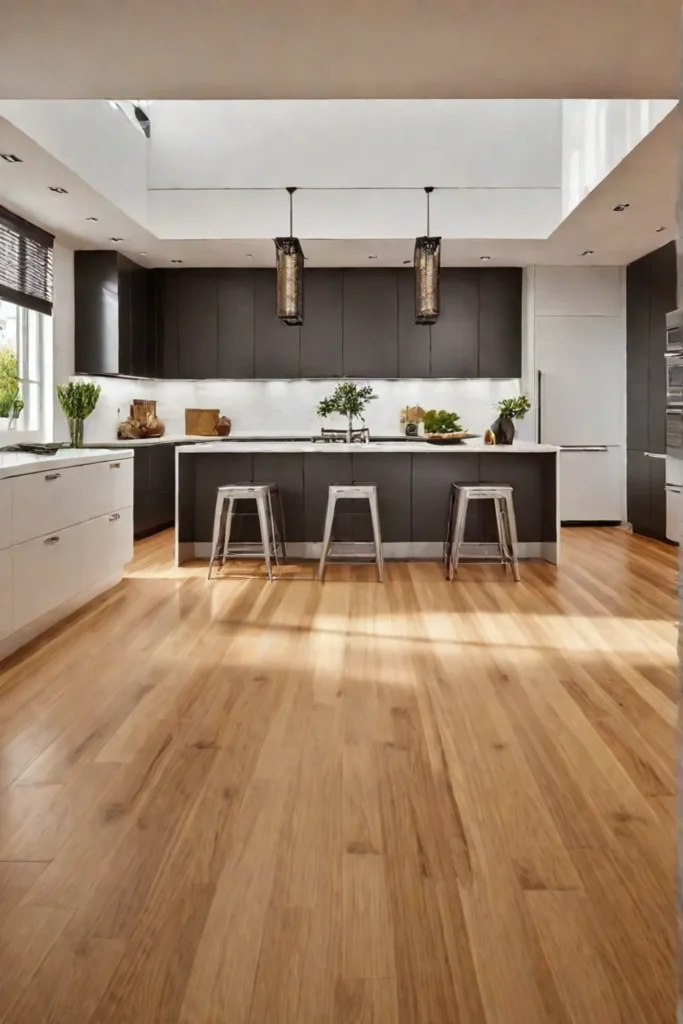
But bamboo isn’t just good for the environment—it’s also incredibly durable and scratch-resistant, making it perfect for high-traffic areas like kitchens. Whether you’re dealing with spills, dropped pots, or energetic kids and pets, bamboo can withstand the demands of a busy kitchen.
And the best part? Bamboo comes in various colors and finishes to complement any kitchen style, from modern and minimalist to rustic and farmhouse-inspired. Opt for darker bamboo with a matte finish for a sleek, contemporary look. Or, for a warm, traditional vibe, choose a lighter, glossy bamboo floor.
No matter your kitchen’s aesthetic, bamboo is a fantastic eco-friendly option that checks all the boxes – sustainability, durability, and design flexibility. Just be sure to work with a professional installer to ensure your bamboo floors are properly prepared and secured for long-lasting performance.
Cork Flooring: Comfort and Sustainability Underfoot
If you’re looking for an eco-friendly flooring option that’s as comfortable as it is beautiful, cork might be the perfect choice for your kitchen. As a home decorator, I’m a big fan of cork because it offers many unique benefits.
First and foremost, cork is a renewable resource. It’s harvested from the bark of cork oak trees, which can be stripped every 9-12 years without harming the tree. This makes cork a truly sustainable material, unlike many other flooring options.
But cork isn’t just good for the environment – it’s also incredibly practical for kitchen settings. Cork is naturally water-resistant and can handle spills and splashes without issues. It’s also easy to clean, requiring a damp mop and mild detergent to keep it looking its best.

Moreover, cork provides a soft, cushioned surface that can help reduce fatigue from standing for long periods while cooking or prepping meals. This makes it an excellent choice for busy home cooks. As a bonus, cork is naturally fire-resistant and hypoallergenic, making it a safe and healthy option for your family.
Regarding design, cork flooring offers various color and pattern options to suit any kitchen style. From modern gray tones to rustic, earthy shades, a cork floor can complement your cabinets, countertops, and other decor elements.
To ensure your cork kitchen floors last for years to come, follow the manufacturer’s instructions for proper installation and maintenance. With a little care, you can enjoy the comfort and sustainability of cork underfoot for a long time.
Linoleum Flooring: A Classic Eco-Friendly Choice
If you’re looking for a timeless, eco-friendly flooring option for your kitchen, linoleum might be the answer. Linoleum has been around for over a century, making a big comeback as homeowners seek more sustainable building materials.
What makes linoleum such a great choice for the kitchen? It’s made from natural, renewable ingredients like linseed oil, cork, and wood flour. This means linoleum is biodegradable and can be recycled, making it a much greener alternative to vinyl or other synthetic flooring options.
But linoleum isn’t just good for the environment—it’s also incredibly durable and long-lasting. This flooring can withstand the demands of a busy kitchen, from spills and heavy foot traffic to the occasional dropped dish. And because linoleum is naturally resistant to mold, mildew, and bacteria, it’s a hygienic choice for food prep areas.
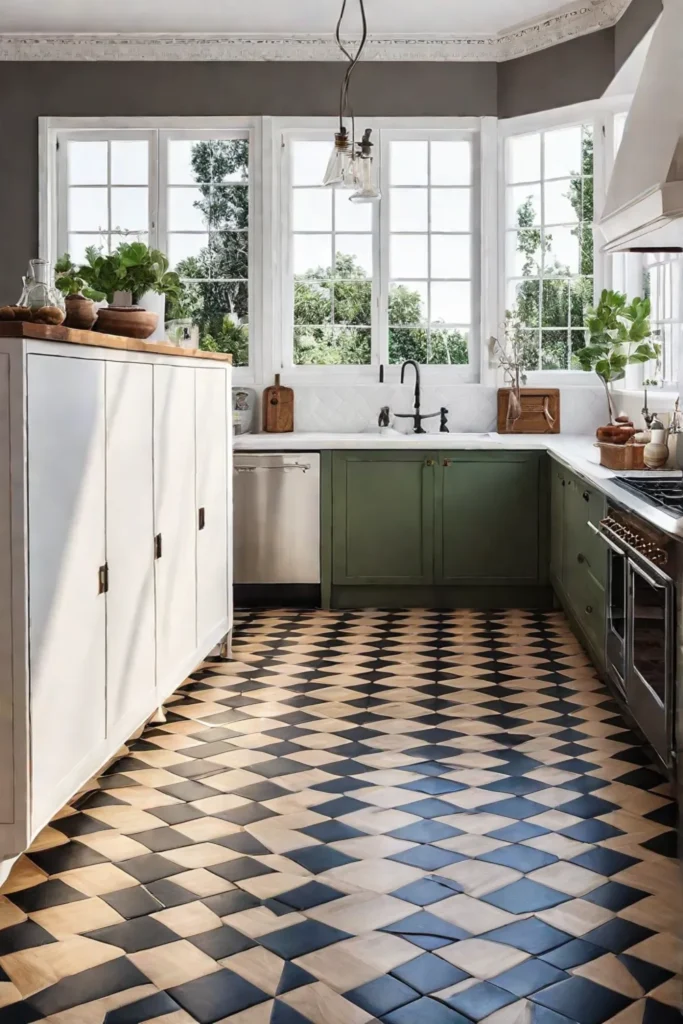
Regarding design, linoleum offers various color and pattern options to suit any kitchen style. Whether you’re going for a retro, minimalist, or farmhouse-inspired look, you can find a linoleum floor that complements your aesthetic. And the best part? Linoleum is often more affordable than other eco-friendly options like bamboo or cork.
To keep your linoleum kitchen floors looking their best, be sure to sweep regularly and use a mild detergent. Avoid harsh chemicals or abrasive tools, as they can damage the surface. With proper care, your linoleum floors can last for decades, making them a smart investment for your sustainable home.
Reclaimed Wood Flooring: Bringing History to Your Kitchen
If you want to add a touch of character and warmth to your kitchen, consider using reclaimed wood flooring. As a home decorator, I’m a big fan of this eco-friendly option because it looks stunning and has a fascinating story behind it.
Reclaimed wood is sourced from old buildings, barns, or other structures that would otherwise end up in landfills. By repurposing these materials, you’re reducing waste and preserving a piece of history. Each reclaimed wood plank has its unique patina and character, making your kitchen truly one-of-a-kind.
However, the benefits of reclaimed wood go beyond its aesthetic appeal. This flooring option is more affordable than brand-new hardwood, as you’re not paying for harvesting and transporting new lumber. The environmental impact of using reclaimed wood is significantly lower than that of traditional hardwood floors.
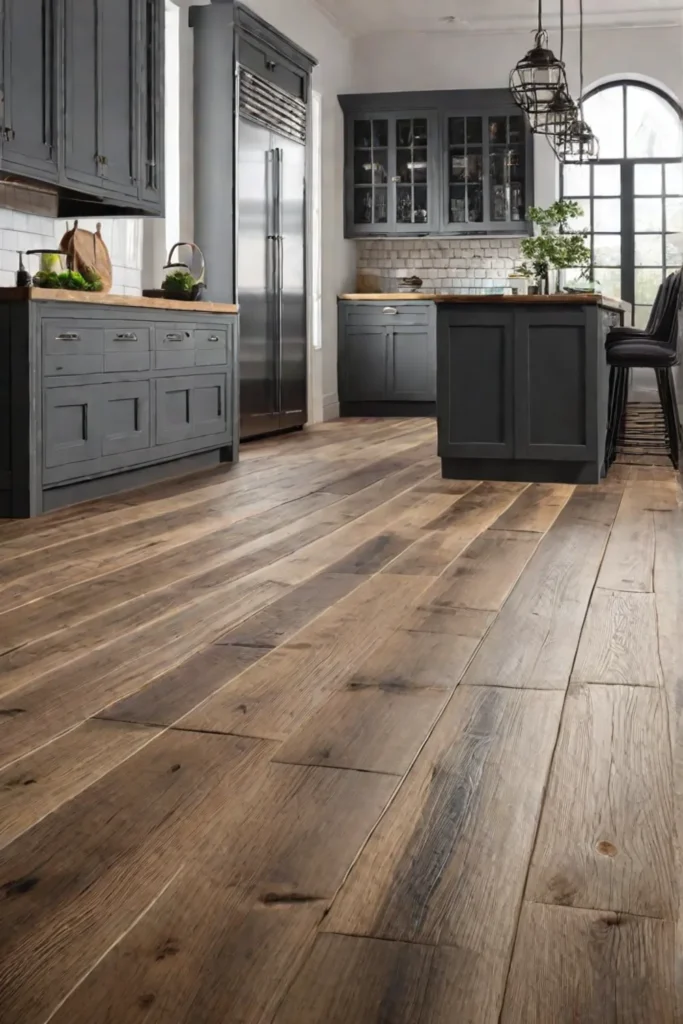
Whether you’re going for a rustic farmhouse vibe or an industrial-chic look, reclaimed wood can perfectly fit your kitchen. Pair it with weathered wooden beams, exposed brick walls, or sleek, modern cabinetry to create a stunning contrast of old and new.
Proper installation and maintenance are key to ensuring the longevity of your reclaimed wood floors. Work with a professional to ensure the planks are properly sealed and finished, and be gentle when cleaning to preserve the wood’s unique character.
With its eco-friendly credentials, timeless appeal, and budget-friendly price tag, reclaimed wood is a fantastic choice for homeowners who want to infuse their kitchen with a little bit of history and a lot of style.
Rubber Flooring: Comfort and Durability in the Kitchen
Rubber is often overlooked when it comes to eco-friendly kitchen flooring, but it’s a fantastic option that deserves some attention. As a home decorator, I love using rubber in kitchens because it offers a unique combination of comfort, durability, and sustainability.
Rubber flooring is made from natural or recycled rubber materials, making it an environmentally-friendly choice. Some rubber floors are even crafted from repurposed tires, which helps to reduce waste and minimize our impact on the planet.
But rubber isn’t just good for the environment – it’s also incredibly practical for busy kitchen spaces. Rubber floors are highly water-resistant, so you don’t have to worry about spills or splashes damaging your floors. They’re also easy to clean, requiring a damp mop and mild detergent to keep them looking their best.

Perhaps one of the biggest benefits of rubber flooring is its cushioned surface. This makes it incredibly comfortable to stand on for long periods, a game-changer for home cooks who spend much time on their feet. The soft, shock-absorbing surface can help reduce fatigue and prevent aches and pains.
Rubber flooring offers a range of design options to suit any kitchen style. From sleek, minimalist monochrome palettes to warm, earthy tones, a rubber floor can complement your cabinetry, countertops, and other decor elements.
To ensure your rubber kitchen floors stand the test of time, choose a thickness that provides the right balance of comfort and durability. Textured surfaces can also offer better slip resistance in wet areas. With proper care and maintenance, your rubber floors can last for years, providing a comfortable and eco-friendly foundation for your kitchen.
Concrete Flooring: A Modern, Sustainable Option
Concrete flooring might be the perfect choice if you’re looking to create a modern, industrial-inspired kitchen. As a home decorator, I’m a big fan of polished concrete because it offers a unique blend of durability, low maintenance, and sustainability.
Concrete is an incredibly durable material that can withstand the demands of a busy kitchen environment. It’s resistant to scratches, stains, and heavy foot traffic, making it a practical choice for high-use areas. Because concrete is a naturally occurring material, it’s also an environmentally friendly option.
But concrete flooring isn’t just about function – it can also add a stunning visual element to your kitchen design. Polished concrete has a sleek, contemporary look that complements modern and minimalist aesthetics. You can customize the color and finish to achieve your desired aesthetic, whether a bold, monochromatic look or a more subtle, earthy tone.
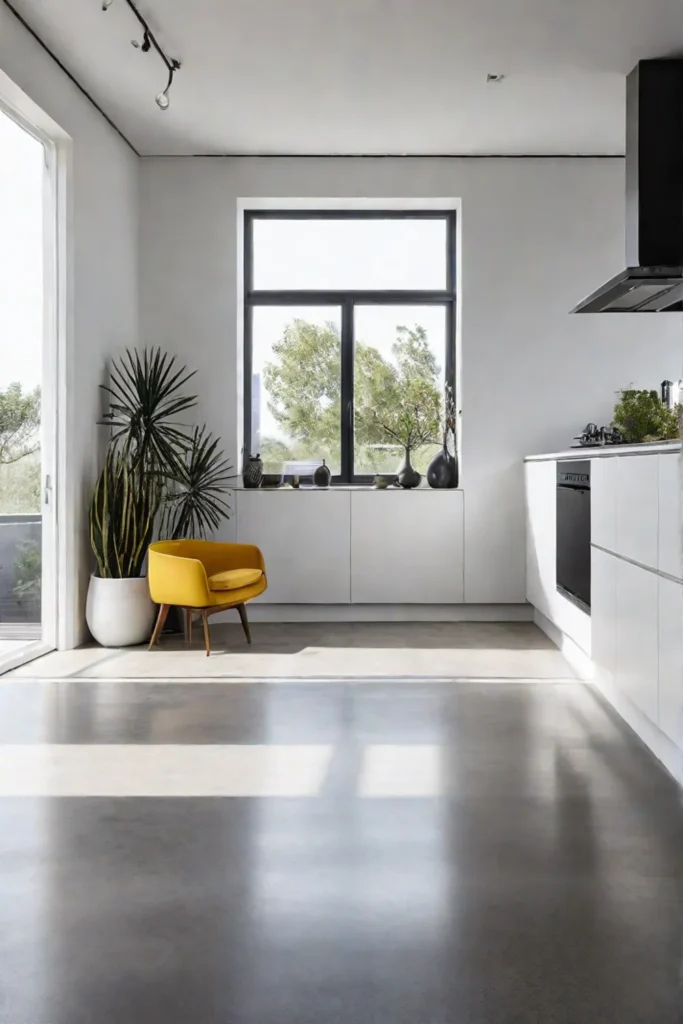
One of the great things about concrete flooring is its low maintenance requirements. Unlike other flooring materials, concrete doesn’t require regular sealing or waxing. A simple damp mop and the occasional deep clean are usually all it takes to keep your floors looking their best.
Of course, proper installation is key to ensuring the longevity of your concrete kitchen floors. Be sure to work with an experienced contractor who properly prepares the subfloor and applies the appropriate sealants and finishes.
By incorporating concrete flooring into your kitchen design, you’ll create a stunning, modern space and make a sustainable choice that can withstand the demands of daily life. And with the right design touches, like area rugs or natural elements, you can warm up the industrial vibe to create a cozy, inviting atmosphere.
Eco-Friendly Tile Flooring: Durability and Design
Tile is a classic choice for kitchen flooring that has stood the test of time. These days, plenty of eco-friendly tile options allow you to create a beautiful, sustainable space.
One of the great things about eco-friendly tile is the wide range of materials and designs. You can find tiles made from recycled glass, porcelain, or natural stone – all of which offer exceptional durability and water resistance, making them perfect for high-traffic kitchen environments.
Beyond the practical benefits, eco-friendly tiles come in various colors, patterns, and textures to suit any kitchen style. Whether you’re going for a modern, minimalist look with sleek, large-format tiles or a more traditional, farmhouse-inspired aesthetic with rustic, handmade terracotta, an eco-friendly tile option fits your vision.
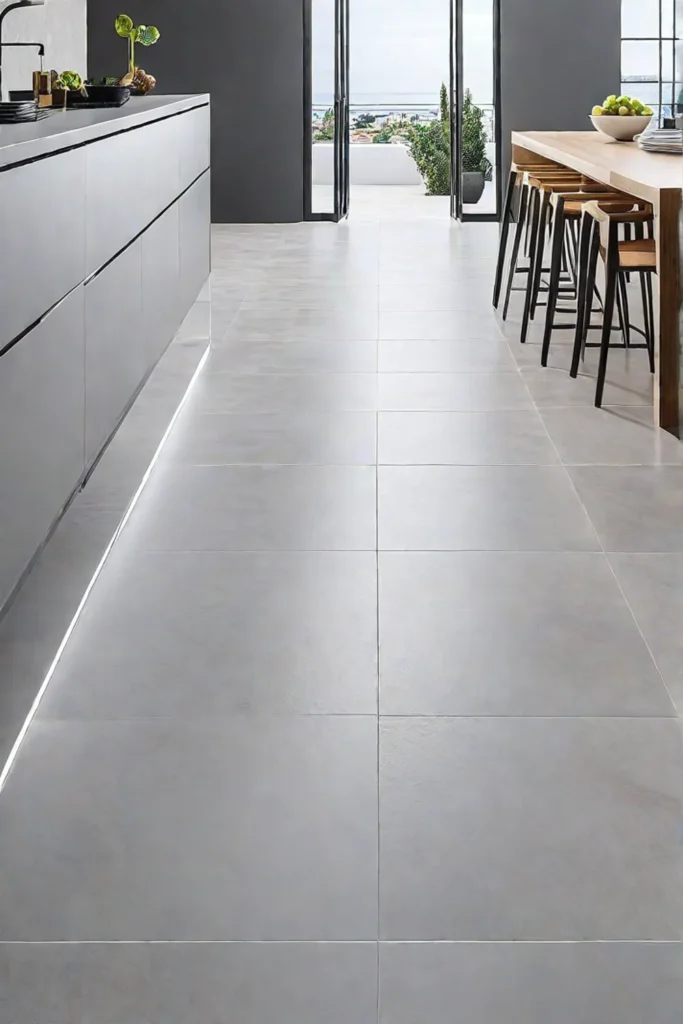
And let’s not forget the environmental impact. By choosing tiles made from recycled or sustainable materials, you’re creating a beautiful kitchen, reducing waste, and conserving natural resources. Many tile manufacturers now offer eco-friendly options that are just as stunning as their traditional counterparts.
Of course, proper installation is key to ensuring the longevity of your eco-friendly tile floors. Work with a professional installer to ensure the subfloor is properly prepared, and the tiles are laid with the appropriate adhesives and grout. With the right care and maintenance, your eco-friendly tile floors can last for years, providing a durable and stylish foundation for your kitchen.
Natural Stone Flooring: Timeless Elegance and Sustainability
Natural stone flooring might be the perfect choice if you want to add a touch of timeless elegance to your kitchen. As a home decorator, I love the unique character and environmental sustainability that natural stone brings to a space.
Natural stone materials like slate, limestone, and travertine are incredibly durable and visually stunning. Each piece of stone is unique, with distinct patterns, veining, and coloration – adding a unique charm to your kitchen design.
But the benefits of natural stone flooring go beyond just aesthetics. These materials are also highly sustainable, as they are naturally occurring and can be quarried and used responsibly. Many natural stone options are even sourced locally, reducing the environmental impact of transportation.

Whether you’re going for a warm, traditional look with a rustic slate floor or a sleek, modern vibe with polished limestone tiles, natural stone can elevate your kitchen design in a beautiful and eco-friendly way.
Of course, proper installation and maintenance are key to ensuring the longevity of your natural stone floors. Work with an experienced contractor to ensure the subfloor is properly prepared, and the stone is sealed and finished correctly. With the right care, your natural stone kitchen floors can last for decades, increasing the resale value of your home.
Conclusion
Your chosen flooring can make a big difference in creating a sustainable, beautiful kitchen. From rapidly renewable bamboo to recycled rubber and timeless natural stone, many eco-friendly options exist.
By incorporating one of these eight flooring ideas into your kitchen renovation, you’re investing in a gorgeous, functional space and positively impacting the environment. Whether you’re drawn to the warm, rustic charm of reclaimed wood or the sleek, modern look of polished concrete, an eco-friendly floor can bring your dream kitchen to life.
So why settle for a dated, unsustainable floor when you can have the best of both worlds – a stunning kitchen that’s also kind to the planet? Start exploring these eco-friendly flooring options today, and get ready to transform your space into a sustainable, stylish oasis.
